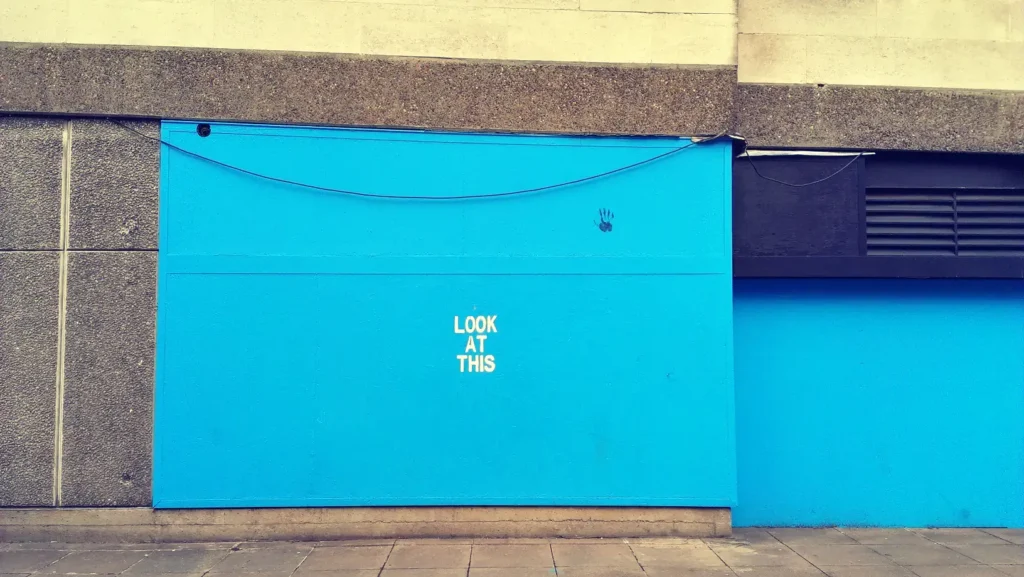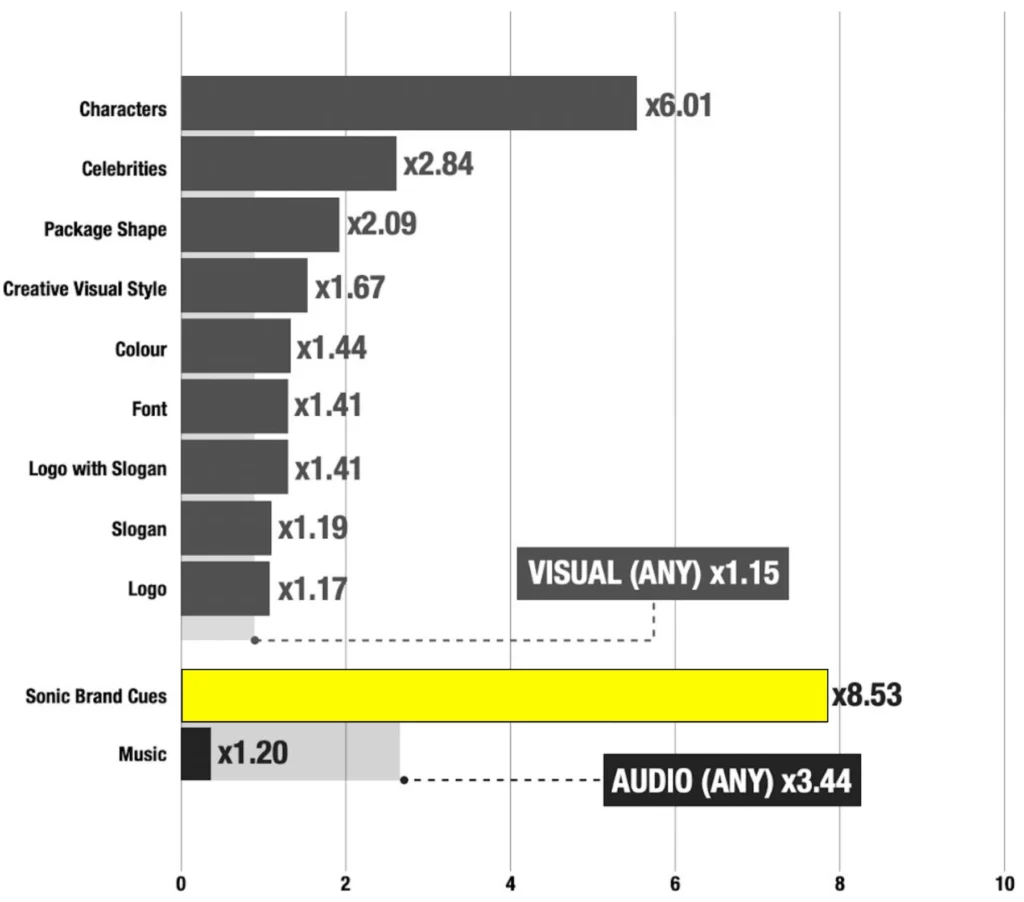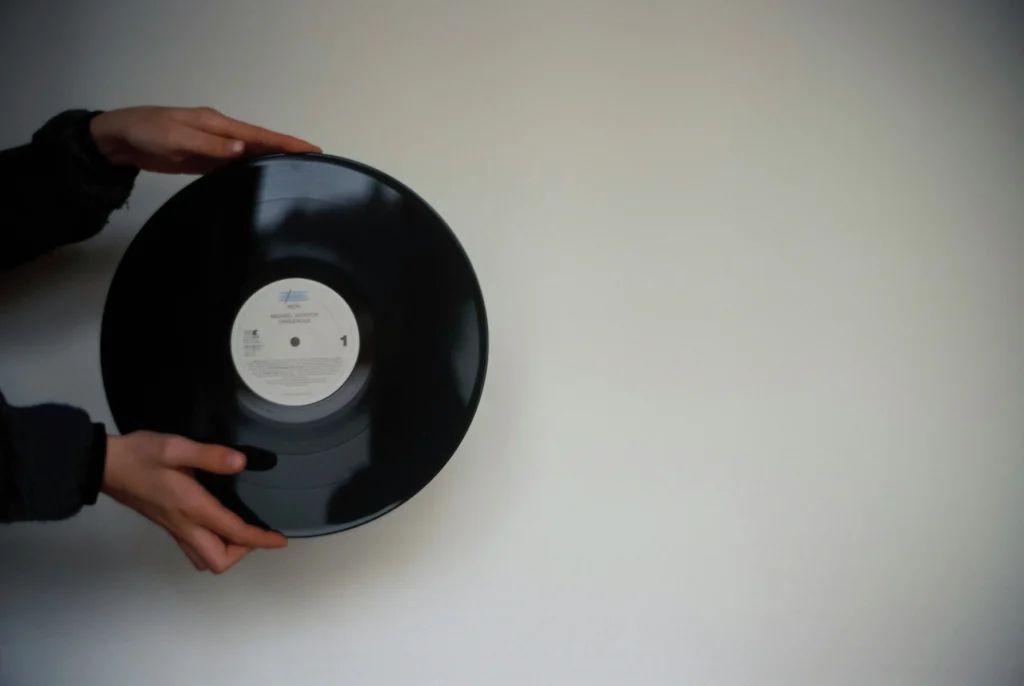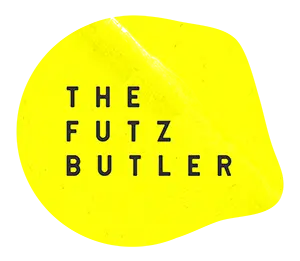Trying to embody your entire brand in sound can feel like a pretty abstract undertaking.
Unlike visual branding, audio branding (sometimes called sonic branding) can understandably feel like a bit of a step into the unknown – both in terms of process and expectations.
With this guide, we’re here to help you avoid the pitfalls that many brands and agencies fall into, ensuring your business reaps the rewards a well-curated audio strategy can deliver.
Let’s get into it…
MISTAKE 1. Let the branding agency handle the audio strategy

Whilst there are clear similarities with other forms of branding, audio branding is a unique niche in and of itself.
Alongside traditional branding practices such as differentiation, recall and recognisability, audio branding also covers more progressive techniques such as UX Sound Design (user experience shaped through sound), Psycho-acoustics (delivering meaning through audio), Product Sound Design and Environmental Acoustemology (devising how the spaces around us sound).
When it comes to positioning a brand, even the most reputable branding agencies tend to think largely in terms of visual languages – colour, typography, motion even lighting, grade and cinematography.
“Our backgrounds, schooling, and professional training are visual – often, in the silent medium of print, information architecture and interaction design. The use of audio is unfamiliar territory and rarely considered. Most of us have not learned and honed techniques for developing effective audio.” Audio and the User Experience by Jonathan Follett
Sound is a completely different animal to visual or written languages.
For starters it’s temporal – it exists only in the moment (actually one of its greatest advantages). The way that it engages our brain’s neural pathways, stimulates emotional response and references memories or other ideas (indexicality) operates on a whole other level to our other senses.
However, it still seems to be the norm to defer how audio will be employed to the branding agency handling the visual strategy. Or riskier still, attempt to do it in-house. A strategy (if there is one) is often stipulated to the audio partner rather than developed in tandem with them as an expert ally who can offer sound-centric insight as to how to use audio effectively.
This inevitably causes creative ceilings, makes the process unnecessarily protracted (costing extra budget) and actively hinders teams getting fresh, effective work out into the world.
Experience, a proven process, combined with an understanding of best practice and available touchpoints (many of which are overlooked by agencies), is the best way to enhance the relationship your users have with your brand in our increasingly ‘sound-on’ world.
MISTAKE 2. Audio logo = Audio branding
This lack of experience dealing with sound-specific brand strategy also means many agencies tend to think quite narrowly about how a brand can be built using sound and music.
Most simply advocate for a mnemonic, or maybe a brand anthem. And whilst that might land, establishing a genuine audio identity means thinking much bigger about what your brand communicates sonically out in the world.
Audio branding is the strategic use of sound and music to enhance customer experiences across ALL interactions with your brand
Curating what they hear in the use of one of your products, on your website or social media, in your advertising, dealing with your customer services, in person in-store / office or at sponsored events – even the sound of the packaging your product comes in, all influence the consumer’s relationship with you.
You wouldn’t hang your entire brand strategy off a single visual asset such as a 2D logo. Yet this is the approach that often happens when it comes to sound
Brands are positioned consistently visually – with colour, shape and motion across multiple consumer interactions and the same care needs to be applied when it comes to audio. We don’t experience the world purely in terms of what we see and gone are the days where our ears are only there to tell us where to direct our eyes. (For some standout examples of how brands are applying this thinking in the real world, read more here: 13 Best Audio Branding Examples)
Brands using consistent sound elements are 35% more likely to be perceived as trustworthy and emotionally engaging and 2/3 consumers associate consistent audio branding with a high-quality brand
It’s this consistency that drives authenticity. And authenticity builds trust. And without trust there’ll never be spend from the consumer, either financially or in terms of time.
MISTAKE 3. Your audio brand must have a melody
One of the most common cliches brands fall foul of is that their audio brand needs to have a melody.
The good news is, this is also one of the easiest wins when it comes to differentiating yourself.
Of the top 200 performing audio mnemonics, 62% of consumers felt favourably towards non-melodic sonic logos (with the number increasing only 5% to 67% for only melodic ones). Meaning overall, people feel pretty much the same way regardless of whether it has a melody or not.

And whilst melody can be brilliantly effective at delivering recall (i.e people remember the tune after it has finished), there is little difference between melodic / non-melodic logos being more appealing or driving propensity to buy.
Sounds themselves can be just as proprietary as any sequence of notes.
For example, a sound design approach can be a hugely effective way to establish differentiation and build a world for your brand to live within. Your audio identity might even be built around sounds your product or service inherently generates in the use of it – sounds that your audience already associates with your product.
Think of Snap, Crackle and Pop, the flip flop of Havaianas or the peeling of Sellotape – you may have ‘assets’ already laying dormant that have precisely nothing to do with a melody but yet are deeply emotive for your audience.
Likewise chords – which are just two or more notes played at the same time – produced in an interesting way, can represent a wonderfully ownable sound. Consider the sound of the opening chords of Underworld’s Born Slippy or a Hard Day’s Night, or even Confused.com’s use of Rumble by Link Wray.
And let’s not forget about rhythm.
It’s a hugely under exploited area of branding – more people can clap in time than sing the tune. Just think of We Will Rock You. Rhythm is inherently more accessible which presents a massive opportunity for the savvy brand.
Your Brand. Your Voice. Your Sound
No clichés. Just original, ownable audio that delivers results.
MISTAKE 4. Approach Audio Branding the same way as a campaign
Applying short term, campaign based thinking to the longer term brand building exercise of audio branding, almost always ends badly.
Whilst of course, most audio assets launch as part of a new activation of some sort, a brand audio asset is very different from a campaign element – it is intended to have a life beyond the campaign itself.
Audio brand assets embody the brand’s core values. Campaign audio’s job is to underpin the narrative of a specific piece of content
The two perform very different functions but should absolutely be complementary. This is where a solid set of brand audio guidelines helps creatives and brand teams build authentic experiences that consumers not only recognise and associate to brand – but trust.
| AUDIO BRAND STRATEGY | CAMPAIGN |
| Long term | Short term |
| All touchpoints / mediums | Specific touchpoints / mediums |
| Creates guidelines | Uses guidelines |
| Sets direction | Follows direction |
Often music from campaign to campaign and across touchpoints bares very little common thread. It creates what Colleen Fahey describes as “multiple brand personality disorder” – a mish-mash of audio that confuses rather than captivates the audience.

High vs Low performing brand asset types in UK advertising (branded attention)
In fact an IPSOS report demonstrated that the audio used by marketing teams and agencies was 3.44 times more likely NOT to be a consistent brand asset than visuals. Meaning, brands are happy to gamble with audio in a haphazard fashion – but not when it comes to what customers see.
Look at these two spots for the same vehicle. The first uses a vintage-tinged, organic and playful jazz quintet-type soundtrack. The other, an obviously modern, brooding cinematic and electronic style. There is no cohesion of brand identity imparted to the audience about who Polestar are (this is especially important for challenger and emerging brands).
MISTAKE 5. Prescribe the deliverables before defining the strategy
There’s an old saying that a little knowledge is a dangerous thing. And nowhere is it more true than audio brand building.
9/10 times we’re approached to collaborate with a brand, the agency comes with a list of deliverables but no clear picture of what success would look like. The brief focuses on inputs – what is needed to be produced, as opposed to outputs – the resulting outcome we’re looking to achieve together.
Audio like any marketing tool has lots of strands to it, and some are better suited to specific objectives than others. Without defining those goals, we can’t know the best tools to deploy to deliver the outcomes that are actually important to you.

For example, a disruption brand new to the market may lean heavier on OOH brand activations and creating authentic brand experiences F2F, using sound to build brand equity through positive UX. Here a mnemonic would have less potency.
However, at the point of wider advertising – digitally, or on TV and radio for example, a mnemonic helps signpost the brand in an incredibly effective way reaching mass audiences.
So it’s about picking the right tool for the job at the right stage of the brand’s development, in a joined up long term strategy.
Being clear with what your objectives are and being open about how this can be delivered with the strategic use of sound is a much healthier approach that yields results far quicker.
MISTAKE 6. Trying to do everything with one sound
As we’ve seen, not all sounds are designed to deliver the same outcomes and fewer still, can do it all. In the same way you wouldn’t attempt to complete building a house with just a hammer, a suite of branded assets is a much better way to realise your targets.

- STRATEGY LED: Gains rapid market traction and parent brand growth via Recall and Attribution. These sounds focus on Appeal and communication of personality of core values. e.g. HERO MNEMONIC
- MARKETING / SALES ROI LED: Acts on the consumer at the Point of Purchase. These assets are less about core brand value / personality and are there to signal Propensity to Buy. Distinctiveness is powerful here. e.g. TRANSACTION CONFIRMATION SOUNDS
MISTAKE 7. Work in departmental silos
Crafting an impactful audio brand isn’t solely the responsibility of marketing, brand accounts, or agency teams. It’s a collective effort that works best with engagement from all stakeholders.
Just as a compelling company motto or a strong culture unites teams, brand assets serve as the embodiment of a company’s values and vision, resonating throughout every level of the organisation. Therefore, it’s crucial for every individual to feel represented and buy into the creative process.

Operating in isolation and presenting work at the last minute invites delays, budget overruns and conflicting opinions, ultimately hindering seeing a ROI, whatever shape that takes.
Contrary to common belief, involving multiple departments doesn’t slow the process or equate to design by committee. Rather, it fosters a sense of ownership essential for pushing forward bold creative ideas through various layers of approval.
Involving key stakeholders from the outset allows diverse viewpoints and agendas to surface early, fostering constructive dialogue. This approach also helps to evaluate creative work objectively against clear targets and goals, minimising the natural subjectivity that surrounds people’s relationship to sound and music.
MISTAKE 8. Expect instant ROI

Like most marketing efforts, audio branding matriculates over time.
Over all, seven of the top ten most recognised (attributed) audio brands in the UK have run consistently for more than five years. It’s an advertising adage that the agency and client get bored of creative work far more quickly than the consumer!

The extent of integration, investment and duration committed to market penetration significantly influence how effectively an audio brand asset signposts the parent brand – a concept referred to as brand attribution.
This is why Netflix is perceived to be so successful – the brand reinforces it’s audio identity at the beginning of each and every stream. Effectively, it has its own ‘channel’ to advertise on indefinitely.
Brand Attribution: how well an audio asset signposts the parent brand
Success in terms of attribution is measured by how rapidly the audio identity assumes the personality of the parent brand with consumers who make the brand connection. A successful measure of attribution is widely agreed to be in the region of 65% (attribution levels of over 90% are usually only reserved for mega brands such as Coca-Cola, armed with deep pockets).
So whilst nobody is asking cost controllers to write an open-ended blank cheque – as we’ve learnt, an audio brand is not a campaign. It is a long-view strategic process that compounds to build loyal consumers. Loyal customers make more repeat purchases, spend more money each time they do and cost less to maintain than converting new customers. Creating loyalty is arguably the ultimate goal of audio branding.
MISTAKE 9. Use commercial tracks as the cornerstone of your audio identity

There are obviously cases whereby the use of existing music can very much underpin a strong brand identity. BA’s use of Lakmé, Act I: Flower Duet, Hamlet’s Air on a G String or more recently, TUI’s repeated use of Ah bah d’accord by Juniore.
But it can be a risky strategy.
We all know why this move gets pulled. Brands hope to cash in on some of the cultural connotations (as well as marketing clout) an artist or band has. But the reality is more often than not, the attribution goes in the other direction. In effect the brand ends up advertising the artist, as the track (and artist) has a life outside of the brand partnership.
When an audience sees an ad with a recognisable track on it, rather than conjure the brand in their minds, it summons the artist. It can be an incredibly expensive mistake with very little brand equity built. It is effectively renting an audio identity, not owning one
And of course, tying your brand to an artist whose profile could come under scrutiny in 21st Century cancel culture very quickly, is undoubtedly a gamble.
For example, Pepsi (unlike their major competitor Coca-Cola – who have consistently brand built with bespoke audio assets), have always favoured brand artist associations. This has landed them in difficult situations on more than one occasion – suffering a multi-million dollar shortfall after having to terminate a brand partnership with Michael Jackson (following allegations of child molestation), with Madonna (following controversy over the Like a Virgin video) and with Britney Spears (with her highly covered public mental health struggles).
Similarly, Wrigley’s (Chris Brown), Kmart (Miley Curus) and Adidas (Kanye West) have all fallen foul of damaging downward turns the result of building their audio brand around an artist.
MISTAKE 10. Get hung up on references and moodboards
Unlike other companies – we don’t tend to use mood boards and playlists.
And here’s the reason…
Not only does this start the project off on an unnecessarily derivative footing, longer pieces of music don’t generally translate to shorter mnemonics or stings. What sounds great as a chorus sounds plain confusing as two seconds of sound.
It’s the same reason we don’t generally advocate for a brand anthem (unless of course the audio strategy is focusing on your internal team).
Lots of our competitors place huge emphasis on a longer brand track. But ultimately these have been proven to have very little bearing on the end user. These brand tracks unquestionably revolve around how they play in boardrooms and marketing departments. Audiences just don’t care, nor are they likely to ever hear it in its full form. So it’s a waste of your time and budget.
Putting a brand anthem at the centre of your audio strategy can cause the whole venture to descend into a misleading vanity project.
Audio should be about deepening the relationship with your users first and foremost.
MISTAKE 11. Demand a Buyout

Most clients (entirely understandably) begin an audio branding project with the notion that they need to buy out the sounds created for them. Often at the request of a well-intentioned but misinformed legal department.
Buying any kind of creator out of intellectual property is incredibly expensive and most often, completely unnecessary. What invariably is needed, is an exclusive blanket licence.
Licensing is the right to use something in an agreed way, on agreed mediums for an agreed period. Buyout is the transference of ownership altogether
Buyout licences have to factor in a potential lifetime value of the IP (some audio assets run for decades), whereas blanket licences cost considerably less as they only charge for the actual period they are being used. So if the brand decide to stop using the assets or wish to develop them in a different direction, they haven’t sunk money into something that is no longer going to be used.
Blanket licenses come in at a fraction of the cost and afford you virtually all the same terms. You will be free to use and exploit the assets in any way you see fit – exclusively.
Blanket licences are negotiated on sensible and realistic time periods, such as two years and five years. Landscapes change quickly – if the audio identity is continuing to perform well at the end of that term, the client simply repeats the license confident they have a proven effective strategy at their disposal.
There’s no downside.
MISTAKE 12. Put brand before user
The last reason may be the most important.
Most brands and agencies see audio branding as another means to bombard their consumers with their message. And with sound, this can easily tip over into being intrusive and just plain annoying.
Good audio branding puts the end consumer first and asks, how does this improve the relationship they have with us as a brand? How does sound improve their UX?
It seeks to earn attention, not grab at it by bombast.
Put simply if it doesn’t improve the consumer’s interaction with your brand – don’t do it. And that’s us as a sound company advocating for that!
Get this wrong and the message it sends to your consumers is ‘we’re more concerned with us as a company, than we are with you as the customer’.
This is where an audio branding specialist really earns their crust. Knowing when, where and why to employ sound across the myriad of touchpoints to deepen the relationship and drive positive results. Not create sonic clutter that simply shouts at your audience.
In conclusion

We get it.
Audio branding can seem like a daunting endeavour. It’s not an easy thing to get right on your own.
But rest assured, with these tips you’ll be in rude health to start your sonic adventure off on the right foot.
We make it our utmost priority to make the process of bringing your brand to life through sound as effortless, creative and ultimately effective as possible. If you’re ready to find out what your brand really could sound like – we’re here to help you make it happen.

